7.1 继承链
1. Ruby
class Animal
def eat
puts 'eat food'
end
end
class Duck < Animal
def eat
puts 'eat fish'
end
end
animal = Animal.new
animal.eat # eat food
duck = Duck.new
duck.eat # eat fish
简单的继承链如下, 包括class关系和superclass关系, 可以通过「向右一步, 向上查找」, 进行方法查找:
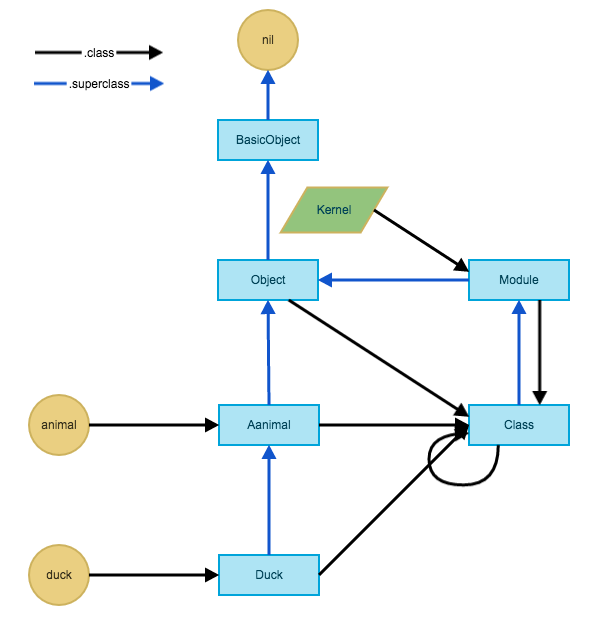
如果加上单键类, 就会比较复杂
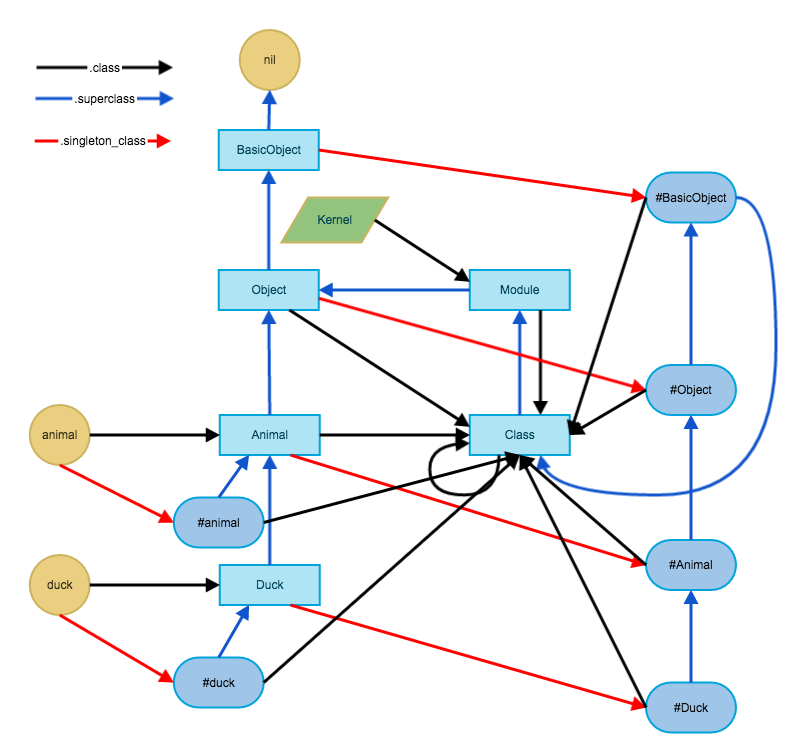
方法查找:
class Animal
def eat
puts 'eat food'
end
# 增加一个类方法
class << self
def count
end
end
end
class Duck < Animal
def eat
puts 'eat fish'
end
end
duck = Duck.new
# duck的单键方法
def duck.fly
puts "I'm a special, I can fly~"
end
对象的实例方法
obj.methods存在于class中(obj.class.instance_methods)duck.methods.grep /eat/ # eat duck.class.instance_methods(false) # eat对象(包括类对象)的单键方法(包括类的类方法)
obj.singleton_methods是定义在对象的单键类中:obj.singletonclass.instance_methods#true duck.singleton_methods(false) == duck.singleton_class.instance_methods(false) # fly #true Animal.singleton_methods(false) == Animal.singleton_class.instance_methods(false) # count一个对象的实例方法的查找, 遵循「向右一步, 向上查找」; 这个「向右」通常找到的是对象的class, 不过, 如果要查找单键方法(包括类查找类方法), 这个「向右」需要从singletonclass开始查找.
2. Javascript
最简单的javascript继承类似这样:
function Animal() { this.age = 0 }
Animal.prototype.eat = function() {
console.log('eat food')
}
function Duck () {}
Duck.prototype = new Animal()
Duck.prototype.eat = function() {
console.log('eat fish')
}
var animal = new Animal()
animal.eat() // 'eat food'
var duck = new Duck()
duck.eat() // 'eat fish'
以上实现有如下问题:
- Duck实例的constructor失真
- 在构造器Animal中的对象属性, 在Duck的对象中没有实现, 仅仅成为了继承属性(原型链上的, 只能读), 而不是对象私有属性(可读可写)
duck.constructor //[Function: Animal]
duck.age // 0 这个属性属于原型链, 而不是duck本身
node.js中的util核心包是node.js自带的核心代码, 其中提供了inherits方法:
var util = require('util');
function Animal() { this.age = 0 }
Animal.prototype.eat = function() {
console.log('eat food')
}
//目的是让this去执行A方法, 这样this可以有A方法里定义的属性 (类似其他语言中调用super)
function Duck() {Animal.call(this)};
Duck.prototype.eat = function() {
console.log('eat fish')
}
util.inherits(Duck, Animal);
var animal = new Animal()
animal.eat() // 'eat food'
var duck = new Duck()
duck.eat() // 'eat fish'
duck.constructor //{ [Function: Duck] super_: [Function: Animal] }
duck.age // duck 自身的属性
注意Animal.call(this), 作用是让this去执行Animal方法, 这样this可以有Animal方法里定义的属性.
再看看inherits的实现:
exports.inherits = function(ctor, superCtor) {
ctor.super_ = superCtor;
ctor.prototype = Object.create(superCtor.prototype, {
constructor: {
value: ctor,
enumerable: false,
writable: true,
configurable: true
}
});
};
- 对子类设置了
super_指向父类 - 子类构造器的prototype采用
Object.create, 其中一个作用就是设定constructor为子类
Javascript 继承链
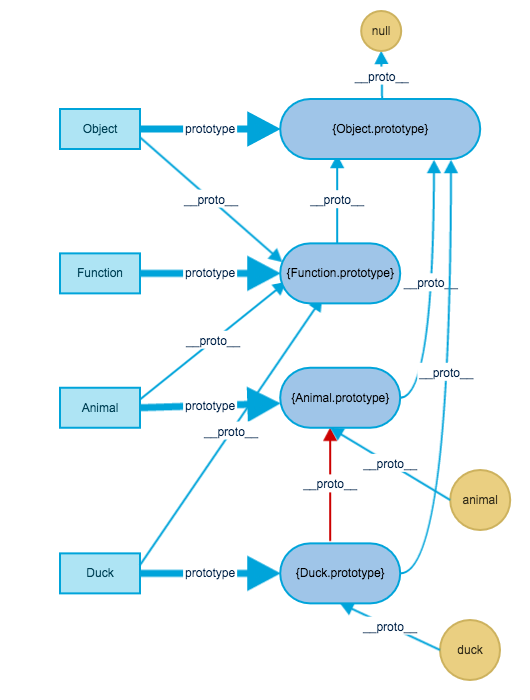
x instanceof y可以理解为:x[.__proto__]+ === y.prototype//[和]和+是正则表达式中的含义因为
duck.__proto__ === Duck.prototype所以duck instanceof Duck 为 true因为
duck.__proto__.__proto__ === Animal.prototype所以duck instanceof Animal 为 true因为
duck.__proto__.__proto__.__proto__ === Object.prototype所以duck instanceof Object 为 true而
duck instanceof Function 为 false__proto__函数: 所有函数的
__proto__指向Function.prototype对象:
手动实现的继承
Duck.prototype = new Animal()子类.__proto__指向父类.prototype除此之外的
__proto__指向Object.prototype
原型链继承的本质是: 在对象上迭代
__proto__直到找到需要的方法.
Ruby继承关系中方法查找有个口诀叫做: 向右一步, 向上查找, 对Javascript继承链稍作调整, 可以看到相似的关系:
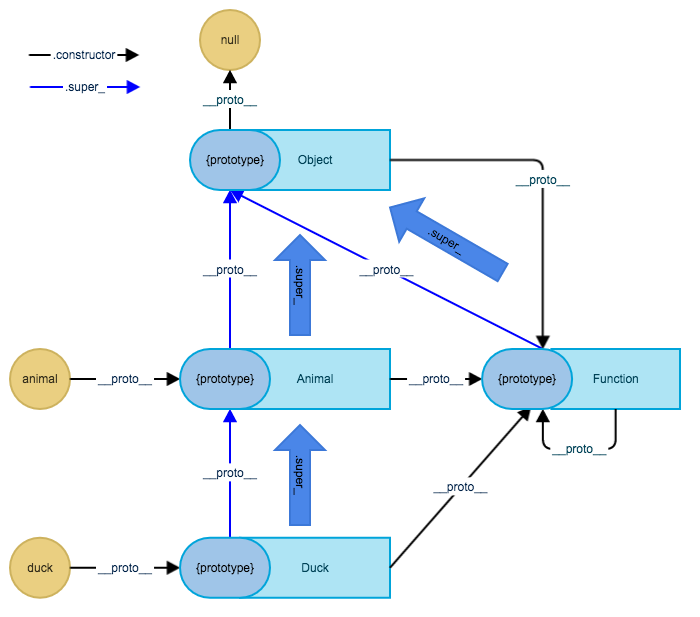
对象和类的关系(黑色箭头)
__proto__类似 ruby中.class如果
obj.__proto__ === klass.prototype那么obj是klass的实例类的继承关系(蓝色箭头)
__proto__类似 ruby中.superclass如果
subklass.prototype.__proto__ === superklass.prototype那么subklass是superklass的子类prototype的作用有点类似ruby中的singletonclass, 都是存放实例方法/属性的地方
Javascript Function 类比 Ruby Class
Javascript Object 类比 Ruby Object
3. Go
Go 没有class, 只有组合, 没有继承.
4. Lua
local Animal = {}
function Animal:new ()
local new_animal = {}
self.__index = self
setmetatable(new_animal, self)
return new_animal
end
function Animal:eat ()
print "eat food"
end
local Duck = Animal:new()
function Duck.eat ()
print "eat fish"
end
local animal = Animal:new()
animal:eat() -- eat food
local duck = Duck:new()
duck:eat() -- eat fish
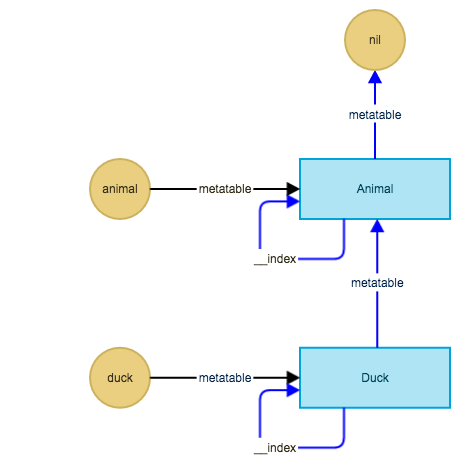
类和实例不是割裂的概念
类Duck和对象animal的创建方式完全一样:
Animal:new(), 类和对象的区分依赖于程序的语义需求.Duck 既是一个类, 也是对象; 或者说Animal本来是一个对象, 但是可以用作一个类.